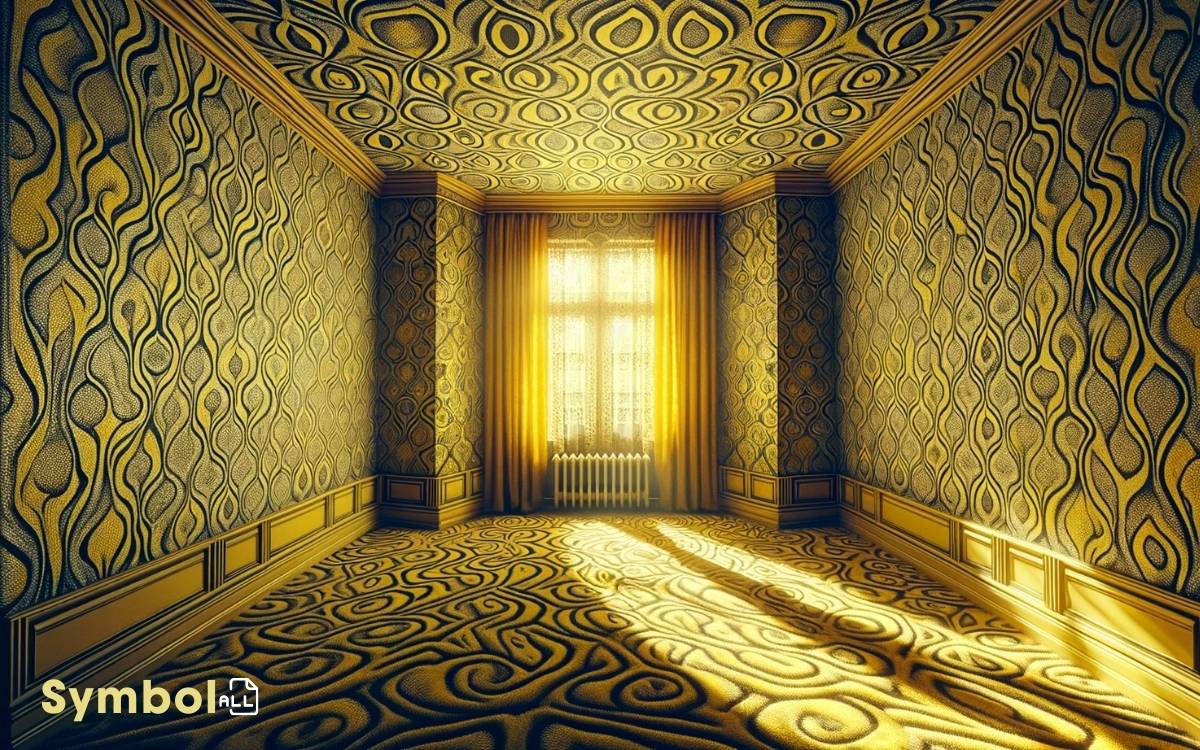What Does the Color Yellow Symbolize in the Yellow Wallpaper
In “The Yellow Wallpaper,” you find yellow symbolizing not just entrapment and isolation, but a vivid descent into mental deterioration and societal oppression.
The color mirrors the protagonist’s struggle against the rigid societal norms, reflecting her mental entrapment within the intricate patterns of the wallpaper. It signifies a decaying spirit amidst the degradation of her social role and creative expression.
As her obsession with the wallpaper grows, yellow becomes a haunting visual of madness, a cautionary hue highlighting the neglect of women’s mental health.
This tale subtly advocates for a reevaluation of women’s roles, hinting at a pathway to liberation and silent rebellion. Continue exploring, and you’ll uncover deeper layers of its symbolic richness.

Key Takeaways
Symbol of Entrapment
In ‘The Yellow Wallpaper,’ the extensive use of yellow symbolizes the protagonist’s deepening entrapment within her own mind and the oppressive confines of her surroundings.
This color, often associated with warmth and sunshine, ironically reflects the protagonist’s growing isolation and madness.
As you explore further, it’s evident that the yellow wallpaper becomes a metaphor for societal constraints on women’s autonomy and mental health.
The wallpaper’s intricate patterns, which initially seem simply unpleasant to the protagonist, gradually become an obsession, mirroring her mental entrapment.
This transformation of the yellow wallpaper from a simple decorative annoyance to a symbol of confinement highlights the protagonist’s struggle against the constraints imposed by her husband and society, underscoring the broader theme of female oppression.
Degradation and Decay
The gradual discoloration and deterioration of the yellow wallpaper in Charlotte Perkins Gilman’s novella not only signify the protagonist’s mental decline but also reflect the broader theme of degradation and decay in women’s social roles and personal autonomy.
| Aspect of Degradation | Explanation |
|---|---|
| Mental Decline | As the wallpaper fades, it mirrors the protagonist’s loss of mental stability, highlighting the decay of her inner world. |
| Social Roles | The decaying wallpaper symbolizes the eroding roles of women, trapped in a society that devalues their autonomy. |
| Personal Autonomy | The deterioration represents the gradual loss of the protagonist’s control over her life, embodying the broader struggle for female independence. |
| Domestic Environment | The unkempt state of the wallpaper reflects the neglect of the protagonist’s needs and desires within her domestic life. |
| Creative Expression | The protagonist’s obsession with the wallpaper’s patterns symbolizes the stifling and eventual decay of her creative expression under societal constraints. |
This analysis reveals how Gilman uses the motif of decay to critique the marginalization and mental deterioration of women in her society.
Illness, Both Mental and Physical
Exploring further, illness, both mental and physical, emerges as a pivotal theme, embodying the protagonist’s struggle and societal views on women’s health.
The color yellow in the wallpaper symbolizes this entanglement of health issues, highlighting:
- The protagonist’s deteriorating mental state, as she becomes increasingly fixated on the wallpaper, reflecting the lack of understanding and proper treatment for mental health in the period.
- Physical confinement, represented by the room and the yellow wallpaper, mirrors the physical ailments and restrictions placed upon women, often dismissed as hysteria or overreaction.
- The societal neglect of women’s health issues, where yellow acts as a cautionary hue, signaling the danger in ignoring or misdiagnosing these conditions.
This interpretation suggests that the color yellow serves as a multifaceted symbol for the complexities surrounding the perception and treatment of women’s health issues.
Obsession and Madness
Yellow wallpaper transforms into a symbol of the protagonist’s descent into obsession and madness, mirroring her entrapment within societal and domestic confines.
As you explore deeper, you’ll notice the wallpaper’s presence isn’t simply decorative but a manifestation of the protagonist’s deteriorating mental state.
It’s not just the color that signifies her unraveling, but the pattern and texture become objects of fixation, representing the complexity and chaos of her thoughts.
This obsession isn’t random; it’s a coping mechanism for her lack of control and agency, a desperate attempt to find meaning in her confinement.
The wallpaper, consequently, becomes a canvas for her madness, a tangible representation of her struggle to assert her identity against the oppressive structures surrounding her.
Feminine Oppression
You observe that ‘The Yellow Wallpaper’ critically addresses feminine oppression through its poignant depiction of mental health stigma and patriarchal control dynamics.
The yellow color symbolizes not only the entrapment of the protagonist but also reflects broader societal constraints on women’s autonomy and psychological well-being.
This narrative strategy exposes the detrimental effects of gender-based discrimination and advocates for a reevaluation of women’s roles both within the family and society at large.
Mental Health Stigma
In ‘The Yellow Wallpaper,’ the color yellow embodies not only the oppressive nature of societal norms on women’s mental health but also highlights the pervasive stigma surrounding mental illness, particularly in the context of feminine oppression.
This stigma manifests in several key ways:
- Silencing: Women’s expressions of mental distress are often dismissed or labeled as hysteria, silencing their voices and experiences.
- Isolation: The protagonist’s confinement reflects how society isolates those deemed mentally ill, exacerbating their condition.
- Misunderstanding: There’s a fundamental misunderstanding and lack of empathy towards the protagonist’s mental health struggles, mirroring societal attitudes towards mental illness.
Understanding these elements invites a deeper reflection on how feminine oppression and mental health stigma intersect, urging a reconsideration of historical and contemporary attitudes towards women’s mental health.
Patriarchal Control Dynamics
The pervasive dynamics of patriarchal control in ‘The Yellow Wallpaper’ serve as a vehicle for exploring the multifaceted aspects of feminine oppression, particularly through the lens of mental health.
You’ll notice how the protagonist’s husband, John, embodies this control, dictating not only her physical surroundings but her access to creative outlets and intellectual stimulation. This mirrors broader societal norms that restrict women’s autonomy and silence their voices.
| Aspect | Effect on Protagonist |
|---|---|
| Physical space | Confinement |
| Intellectual | Stifling |
| Emotional | Isolation |
| Creative | Suppression |
| Autonomy | Loss |
Your understanding of these dynamics isn’t just academic; it’s a lens through which you can discern the ongoing struggle for gender equality and mental health awareness.
Fading Hope and Desperation
As you examine the symbolism of yellow in ‘The Yellow Wallpaper,’ consider how the hue mirrors the protagonist’s journey from hope to despair.
The diminishing light of hope parallels her escalating sense of despair, illustrating a profound transformation within her psyche.
Moreover, the illusions of freedom, once bright and promising, gradually fade, underscoring the depth of her desperation.
Diminishing Light of Hope
Yellow’s mutating hues in ‘The Yellow Wallpaper’ mirror the protagonist’s dwindling hope and escalating desperation, encapsulating her struggle.
Initially, the wallpaper’s color might seem merely distasteful, but it quickly becomes a symbol of her fading vitality and diminishing optimism.
As you investigate further into the narrative, consider how:
- The color’s initial vibrancy fades into sickly shades, reflecting her weakening spirit.
- Each transformation of hue marks a step further away from hope and closer to despair.
- The omnipresence of yellow in her confined space symbolizes the inescapability of her mental and emotional decline.
This degradation of color not only signifies the protagonist’s loss of hope but also serves as a metaphor for her increasingly desperate attempts to find meaning and liberation within her oppressive environment.
Escalating Sense of Despair
Within the confines of her oppressive environment, the protagonist’s journey into despair deepens, mirroring the fading hope and increasing desperation that the yellow wallpaper symbolizes.
The color yellow, often associated with light and vitality, paradoxically becomes a marker of her dwindling spirit. It’s as if the vibrancy of the wallpaper drains her own vitality, reflecting her escalating sense of entrapment.
This shift in symbolism from potential brightness to a manifestation of despair underscores the protagonist’s psychological decline. The wallpaper’s intricate patterns, which initially suggest a form of escape, gradually morph into a visual representation of her fractured psyche.
Consequently, the yellow wallpaper evolves from a mere decorative element to a profound symbol of the protagonist’s escalating despair, encapsulating her diminishing hope and mounting desperation in a world that seems increasingly constrictive.
Illusions of Freedom Fade
The protagonist’s initial perception of the yellow wallpaper as a symbol of potential escape gradually reveals itself to be an illusion, marking a deeper descent into despair and entrapment.
This shift underscores a journey from hope to hopelessness, as you’ll see through:
- The wallpaper’s evolving imagery, transforming from a mere disturbing pattern to a prison of her own mind, mirrors her fading hope.
- Her obsessive interaction with the wallpaper, once a curious engagement, becomes a desperate attempt to find meaning or release.
- The final breakdown, symbolizing not liberation but a complete loss of self, reveals the wallpaper’s true nature as a barrier to freedom, not a doorway to it.
Through this lens, the yellow wallpaper transcends its initial appearance, embodying the protagonist’s illusions of freedom and their inevitable dissolution into despair.
Liberation and Transformation
In ‘The Yellow Wallpaper,’ yellow symbolizes the protagonist’s journey from oppression to liberation, marking a transformative process steeped in complexity and nuance.
Initially, the wallpaper’s hue represents the societal constraints binding her, reflective of a maddening, enforced domesticity.
As you explore further, it’s evident that the color yellow also embodies a form of silent rebellion. The wallpaper’s intricate patterns, which initially confine, begin to suggest a pathway to freedom.
The protagonist’s fixation and eventual identification with the woman trapped behind the wallpaper signify a breaking point, where liberation from her own psychological imprisonment becomes possible.
This metamorphosis from captivity to release isn’t just a personal victory but a commentary on the broader struggle for female autonomy and self-expression.
Conclusion
In ‘The Yellow Wallpaper,’ the color yellow transforms from mere decoration to a profound symbol of your entrapment and descent into madness. It’s not just the walls that confine you; it’s the societal norms and expectations that paint your reality.
As you peel away each layer, you’re not just uncovering decay and illness, but also the desperation for freedom and self-expression stifled by feminine oppression.
Ultimately, the yellow embodies your liberation and transformation, offering a haunting yet cathartic revelation.






